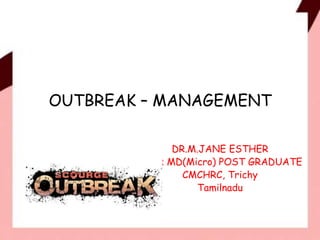
Outbreak – management
- 1. OUTBREAK – MANAGEMENT DR.M.JANE ESTHER II YR MD(Micro) POST GRADUATE CMCHRC, Trichy Tamilnadu
- 2. Contents • Definition of an outbreak • History of worst outbreaks • Investigations • Management • Institutional outbreak
- 3. OUTBREAK - DEFINITION • The occurrence in a community or region of cases of an illness with a frequency clearly in excess of normal expectancy.
- 4. Worst outbreaks - history • Ebola – 2014-2015
- 5. Plague – black death 400 BC
- 6. Small pox – 1492 to 1900
- 7. Yellow fever epidemic • 1793
- 11. Malaria • 2800 children – die each day
- 12. AIDS • From 1981
- 13. INVESTIGATIONS • Regardless of the communicable disease, the procedure for the investigation of a suspected outbreak is the same • 10 Steps
- 15. 1.Establish the existence of an outbreak • Compare current information with previous incidence in the community during the same time of year to determine if the observed number of cases exceeds the expected. • Compare available information about new cases with a predetermined definition of an outbreak.
- 16. 1.Establish the existence of an outbreak • Public health surveillance. • Gather reports of illnessess • Doctors and microbiologists – notify • Public health officials – look at reports • Astute clinician • Specimens collected – organism identified • Serotyping / DNA fingerprinting/ PFGE
- 17. 2.Confirm the diagnosis • Analyze clinical histories of cases • Have standard laboratory tests performed to confirm or reject the suspected diagnosis • To determinethe type of agent associated with the illness (e.g.,bacterial, viral, other).
- 18. 3.Establish the case definition and count cases Case definition • Features of the illness • The pathogen or toxin, if known • Certain typical symptoms • Time range • Geographic range,
- 19. Case count • The number of cases that meet the case definition is called the case count.
- 20. 4.Relate the outbreak to time, place and person • Characterize the outbreak according to person, place or time by interviewing known or selected cases • When they became ill (time) • Where they became infected (place) • Who they are (person).
- 21. 5.Formulate a tentative hypothesis To explain the most likely • Cause • Source – Mode of transmission • Distribution – Location, age • Example : Food borne illness what they ate? Where ? – before they became ill • Time after intake • Challenge : Memory
- 22. 6.Testing the hypothesis • Analytical studies – compare ill with healthy • H/O sickness – particular food – association • Frequencies of exposure to a specific food item • Strength of the statistical association • The food’s production, preparation and service • The food’s distribution
- 23. Testing a hypothesis • Food studies (in food borne outbreak) • Finding bacteria with the same DNA fingerprint in an unopened package of food and in the stool samples of people in the outbreak can be convincing evidence of a source of illness
- 24. 7.Finding the Point of Contamination • Environmental assessment • Who cooked? • Ingredients • Steps followed • Temperature • Health status of workers
- 25. 8.Epidemiologic investigations & Report writing • Summarize and interpret all of the information that has been collected • Examine the results of laboratory tests that have been conducted. • Construct epidemic curves, tables and charts. • On the basis of the available data and the appropriate calculations- accept or reject the hypothesis.
- 26. 9.Controlling an Outbreak • Once the source of illness is found – control measures • Isolating the source (patient) • Discarding the food • Temporary closure of restaurant • Disinfection of the room/ ward • Inform public
- 27. 10.Deciding an Outbreak is Over • An outbreak ends when the number of new illnesses reported drops back to the number normally expected. • The epidemic curve helps investigators see that illnesses are declining. • Public health officials - continue surveillance for a few weeks • Continue or restart their investigation – if cases start occuring again
- 29. Practical Considerations • Regional Health Authority (RHA)- routine surveillance – early identification of outbreaks • A plan for the investigation of outbreaks • Each RHA- establish direct contact with Laboratory • A line-listing of cases and contacts – should be maintained electronically • Outbreaks be reported to the Director of Communicable Disease Control
- 30. Management of Outbreaks in Institutions • Each facility should have a plan in place for routine surveillance and for outbreak investigation – RHA should be aware of it • Team approach by the facility staff and Regional Health Authority (usually the Medical Officer of Health or delegate) • Provincial Infection Control Nurse should be informed of and involved in the outbreak investigation.
- 31. • It may be difficult to recognize an outbreak in a health- care facility • The Regional Health Authority - should establish circumstances under which they are to be notified. • Those where public health intervention or expertise may be required (e.g., foodborne illness, influenza).
- 32. • Food-borne outbreaks potential to spread • Early consultation with a public health inspector/ Provincial Infection Control Nurse responsible for communicable diseases is strongly recommended
- 33. summary • Definition • Recent and remote outbreaks • 10 steps of management • Investigations to be carried out • Management of institutional outbreaks
- 34. References • Epidemiological investigation of an outbreak – communicable disease management protocol manual • Outbreak management – CDC guidelines